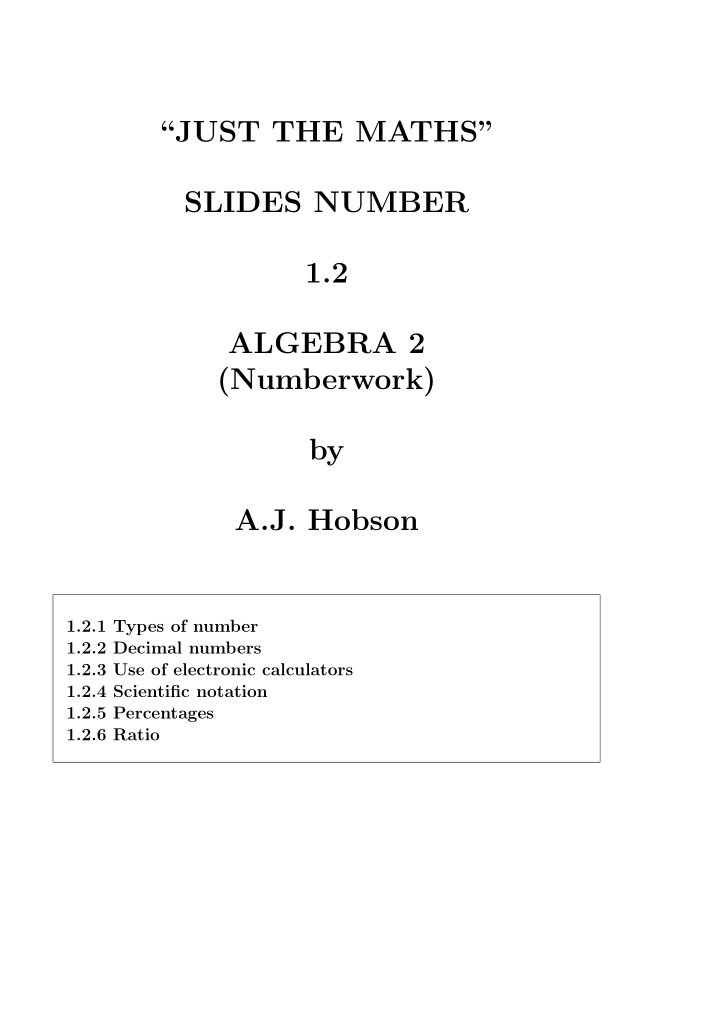



“JUST THE MATHS” SLIDES NUMBER 1.2 ALGEBRA 2 (Numberwork) by A.J. Hobson 1.2.1 Types of number 1.2.2 Decimal numbers 1.2.3 Use of electronic calculators 1.2.4 Scientific notation 1.2.5 Percentages 1.2.6 Ratio
UNIT 1.2 - ALGEBRA 2 NUMBERWORK 1.2.1 TYPES OF NUMBER (a) NATURAL NUMBERS 1 , 2 , 3 , 4 , ....... (b) INTEGERS ...... − 5, − 4, − 3, − 2, − 1, 0, 1, 2, 3, 4, 5, ...... (c) RATIONALS The ratio of two integers or a terminating decimal or a recurring decimal 5 = 0 . 4 and 3 2 7 = 0 . 428714287142871 .... (d) IRRATIONALS Neither the ratio of two integers nor a recurring decimal √ π ≃ 3 . 1415926 ....., e ≃ 2 . 71828 ..... 2 ≃ 1 . 4142135 .... √ 5 ≃ 2 . 2360679 .... The above four types of number form the system of “Real Numbers”. 1
1.2.2 DECIMAL NUMBERS (a) Rounding to a specified number of decimal places When rounding to n decimal places, the digit in the n - th place is left as it is when the one after it is below 5; otherwise it is taken up by one digit. 362.5863 = 362.586 to 3 decimal places; 362.5863 = 362.59 to 2 decimal places; 362.5863 = 362.6 to 1 decimal place; 362.5863 = 363 to the nearest whole number. (b) Rounding to a specified number of signifi- cant figures The first significant figure of a decimal quantity is the first non-zero digit from the left, whether it be before or after the decimal point. 0.02158 = 0.0216 to 3 significant figures; 0.02158 = 0.022 to 2 significant figures; 0.02158 = 0.02 to 1 significant figure. 2
1.2.3 USE OF ELECTRONIC CALCULATORS (a) B.O.D.M.A.S. 7 . 25 + 3 . 75 × 8 . 32 = 38.45, not 91.52. 6 . 95 ÷ [2 . 43 − 1 . 62] = 8.58, not 1.24 (b) Other Useful Numerical Functions √ x , x 2 , x y , x 1 y , using, where necessary, the “shift” control √ 173 ≃ 13 . 153 , 173 2 = 29929 , 23 3 = 12167 , 23 1 3 ≃ 2 . 844 (c) The Calculator Memory For (1 . 4) 3 − 2(1 . 4) 2 + 5(1 . 4) − 3 ≃ 2 . 824, store each of the four terms in the calculation (positively or negatively) then recall their total sum at the end. 3
1.2.4 SCIENTIFIC NOTATION (a) Very large numbers written as a × 10 n n is a positive integer a lies between 1 and 10. 521983677 . 103 = 5 . 21983677103 × 10 8 (b) Very small numbers written as a × 10 − n n is a positive integer a lies between 1 and 10. 0 . 00045938 = 4 . 5938 × 10 − 4 Note: Enter numbers by using the EXP or EE buttons 4
EXAMPLES 1. Key in the number 3 . 90816 × 10 57 on a calculator. Press 3.90816 EXP 57 2. Key in the number 1 . 5 × 10 − 27 on a calculator Press 1.5 EXP 27 +/- Notes: (i) Scientific notation is also called floating point notation . (ii) Accuracy = one significant figure more than the least number of significant figures in any measurement. 1.2.5 PERCENTAGES Definition A percentage is a fraction whose denominator is 100. 17 100 = 17% EXAMPLES 1. 2 5 = 2 5 × 20 20 = 40 100 = 40% 2. 27% of 90 = 27 100 × 90 = 27 10 × 9 = 24 . 3 5
3. 30% = 30 100 = 0 . 3 1.2.6 RATIO We may use a colon (:) eg. 7:3 instead of either 7 ÷ 3 or 7 3 . 7:3 could also be written 7 3 :1 or 1: 3 7 . EXAMPLES 1. Divide 170 in the ratio 3:2 170 is made up of 3 + 2 = 5 parts, each of value 170 5 = 34. 3 × 34 = 102 and 2 × 34 = 68. 170 = 102 + 68 2. Divide 250 in the ratio 1:3:4 250 is made up of 1 + 3 + 4 = 8 parts, each of value 250 8 = 31 . 25. 3 × 31 . 25 = 93 . 75 and 4 × 31 . 25 = 125. 250 = 31 . 25 + 93 . 75 + 125. 6
Recommend
More recommend